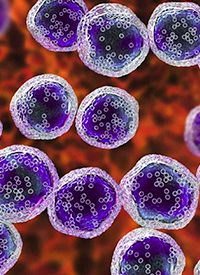Article
Low-Dose Belantamab Mafodotin/Nirogacestat Demonstrates Encouraging Clinical Activity in R/R Myeloma
Author(s):
Nirogacestat plus belantamab mafodotin induced promising responses with manageable safety for patients with relapsed/refractory multiple myeloma.
Multiple Myeloma

Nirogacestat (PF-03084014) plus belantamab mafodotin-blmf (belamaf; Blenrep) induced promising responses with manageable safety for patients with relapsed/refractory multiple myeloma (RRMM), according to findings from the phase 1/2 DREAMM-5 study (NCT04126200) presented at the 2022 ASCO Annual Meeting.1
The phase 1/2 platform study incorporated a master protocol evaluating multiple belamaf-containing combinations to identify effective treatment regimens in specific disease subgroups. These data including findings from a substudy of 10 patients assigned to 0.95 mg/kg of belamaf every 3 weeks plus continuous nirogacestat. Results from a planned interim analysis of this dose escalation cohort led to the opening of a cohort expansion arm with 14 more patients. Another 14 patients were randomly assigned to 2.5 mg/kg belamaf monotherapy every 3 weeks.
The overall response rate (ORR) for the combined dose escalation and cohort expansion cohorts (n = 24) was 38% (95% CI, 18.8%-59.4%) vs 50% (95% CI, 23.0%-77.0%) in the monotherapy arm. However, more patients in the combined cohort had stringent complete response (CR; 4 vs 0) or CR (5 vs 0). The clinical benefit rate was 50% (95% CI, 18.8%-59.4%) in the combined arm vs 57% (95% CI, 28.9%-82.3%) for monotherapy.
Investigators previously evaluated belamaf monotherapy for patients with heavily pretreated RRMM in the DREAMM-2 study (NCT03525678). The ORR was 32% (97.5% CI, 21.7%-43.6%) in 13-month follow-up data.2
Nirogacestat is a gamma secretase inhibitor that prevents the cleavage of several transmembrane proteins, including membrane-bound B-cell maturation antigen (BCMA). This releases the extracellular domain as soluble BCMA into circulation, interfering with and limiting efficacy of BCMA-directed therapies. Preclinical data demonstrated that nirogacestat may increase cell surface levels of BCMA and reduce soluble BCMA levels, which may enhance the activity of the anti-BCMA agent in multiple myeloma.
To determine whether adding nirogacestat to low-dose belamaf produced similar efficacy as single-agent belamaf, investigators recruited adults with RRMM who received at least 3 prior lines of therapy including a proteosome inhibitor, an anti-CD38 monoclonal antibody, and immunomodulatory agent. Other requirements included an ECOG performance score of 0 or 1 and treatment with stem cell transplantation, if feasible. Patients who were administered a monoclonal antibody within 30 days of enrollment, received prior therapy with an agent targeting PD-1, PD-L1, or PD-L2; or received treatment with a coinhibitory T-cell receptor–directed agent were excluded.
The median age in the combined cohort was 71.3 years (range, 55-86) compared with 65.5 years (range, 56-80) in the monotherapy arm. Fifty percent of patients where women in the combined cohort compared with 64% in the monotherapy arm.
Patients in the combined cohort received a median of 4.25 prior lines of therapy, compared with 4.5 in the monotherapy cohort. In the combined cohort, 6 patients had extramedullary disease compared with 1 in the monotherapy arm.
There were 2 fatal serious adverse effects (AEs) in the dose-expansion cohort: an intracranial hemorrhage and sepsis. In the cohort expansion group, there was 1 fatal case of hematuria and 1 fatal case of COVID-19 infection. There was 1 incident of fatal COVID-19 infection in the monotherapy arm. Investigators determined none of these deaths was related to the study treatment.
All patients in the dose-expansion cohort experienced grade 3 or higher, AEs compared with 86% each in the cohort-expansion and monotherapy cohorts. Of those, 9 (90%) in the dose expansion cohort, 11 (79%) in the cohort expansion group, and 5 (36%) in the monotherapy group were related to treatment with belamaf.
Two (20%) patients in the dose-expansion cohort and 1 (7%) in the cohort-expansion group required permanent discontinuation of study treatment. There were no discontinuations in the monotherapy group.
There were 7 (29.1%) incidents of grade 3 or higher blood and lymphatic AEs in the combination arm, compared with 2 (14%) with monotherapy. Five patients (20.8%) in the combined arm experienced grade 3 or higher thrombocytopenia vs 2 in the monotherapy arm.
Investigators assessed ocular events based on the Common Terminology Criteria for Adverse Events-5 scale and the keratopathy and visual acuity scale. There were 12 any-grade events in the monotherapy arm, compared with 13 in the combination arms. Seven (50%) of those events were grade 3 in the monotherapy arm compared with 3 (12.5%) in the combination arm.
References
- Lonial S, Grosicki S, Hus M, et al. Synergistic effects of low-dose belantamab mafodotin in combination with a gamma-secretase inhibitor (nirogacestat) in patients with relapsed/refractory multiple myeloma (RRMM): DREAMM-5 study. J Clin Oncol. 2022;40,(suppl 16; abstr 8019). doi: 10.1200/JCO.2022.40.16_suppl.8019
- Lonial S, Lee HC, Badros A, et al. Longer term outcomes with single-agent belantamab mafodotin in patients with relapsed or refractory multiple myeloma: 13-month follow-up from the pivotal DREAMM-2 study. Cancer. 2021;127(22):4198-4212. doi: 10.1002/cncr.33809









